It occurred almost every game, and though the first half was almost always the same time from game to game, the second stanza was all over the place. There had to be a reason.
Tim Brown over at Football Archaeology had the answer and he also shared it in a post he wrote and in a conversation on our podcast.
Transcribed Conversation of Timothy Brown on the House of the Setting Sun
Hello, my football friends; this is Darin Hayes of PigskinDispatch.com. Welcome once again to The Pig Pen, your portal to positive football history. And welcome to Tuesday, FootballArcheology.com day. We have Timothy P. Brown, the founder of FootballArcheology.com, joining us as he does each and every week to talk about one of his famous tidbits.
Tim, welcome back to The Pig Pen. Darren, good to see you, see your smiling face. It is about time.
About time. Yeah, great segue. Your segue-isms are getting better and better each and every time.
I am upping segue game. The dad jokes are a-flying, that's for sure. But Tim, now that you set it up, you have an interesting article from back in September that maybe back in September didn't mean as much as it does this time of year as we're getting closer to the winter season.
The sun going down affected the timing of games. I'll let you take it from there and tell us all about your tidbit. Yeah, so actually, the interesting thing is there is an unidentified reader.
I can't say who that is unless the reader gives permission. The reader gives you permission, Tim. Go ahead.
Oh, OK. So, one time, Darin asked me. Why is it always me? So, yeah, so just, you know, it's like anything else.
You know, you question, you go like, how did this work? So, as he was doing his own research on some things, he kept on seeing in the old newspapers. You know, 1800s and early, you know, 1900s. Oftentimes, the box score would have a little thing right at the bottom of the box, and it would say, you know, time of halves or time of quarters.
It would say 15 minutes, 15 and 10, or something like that. And so, and then typically, if there was a short quarter or a short half, it was the second half. So, you know, the question is basically, well, why the heck did they do that? Why did they shorten games? And so sometimes that happened because one team was getting blown out, but that was not generally the reason, you know, so even in tight games, it wasn't unusual to shorten, shorten a quarter or a half.
And so, you know, when I wrote it, I kind of used the, you know, the old terminology of de jure versus de facto. So de jure means, you know, by the rule or by the law, whereas de facto is in practice. Right.
And so when football first started, when we first brought it in, you know, when we were playing rugby. Football was just one of those stew of games that came out of, you know, 18th-century England and the norm was to play 45-minute halves. And so soccer still plays 45-minute halves, and rugby still plays 45-minute halves.
And when football got started here, we were playing 45-minute halves even though there was nothing in the rules that said that's how long it was. You know, the original football rules don't mention how long a game is supposed to last, but everybody knew it was 45 minutes. So that's what you did.
When football kind of, you know, as partly safety measures, you know, they were trying to give people rest and just reduce the amount of time that they're on the field. You know, football started, it went to 45 minutes and then 35 and then 30. And it's perhaps so.
Now, another tradition that was quite common was that, a lot of times, games started at about 2 o'clock or 2:30 in the afternoon. And so part of that was, you know, you had a lot of people, you know, fans who, you know, if they were factory people, they and, you know, clerks and whatnot, they work six days a week, as did their bosses. And if they were rural folks, well, farm chores have to be done.
You know, if you got a dairy herd, well, guess what you're doing every day. You know, so just from a lifestyle standpoint, a lot of people had things to do in the morning. On top of that, a lot of teams didn't have the budget to send their team to an away game and stay overnight.
So, you know, they would want to be able to take the train in the morning of the game, show up, play the game, turn around, and get home. And so not only did that mean they had to schedule a game a little bit later, but then there were times where they needed to, you know, the only way they would get home and make their connections that night was to be at the train station at, you know, 430 and or, you know, five o'clock or whatever it was. So, you know, for a combination of reasons, they ended up needing to cut games short.
And eventually, the rule makers, you know, it was kind of an understood thing. It wasn't. Again, it's one of those traditions.
It was, you know, in fact, people cut games short, even though the rules didn't say, you know, didn't allow it. But everybody did it. Right.
So, then we end up in a situation where, you know, during World War One, the government instituted light savings time, daylight saving, no S on that, daylight saving time. And so that came into effect in 1918. And so that was the first time that anybody had experienced that, at least, you know, in the US.
So you just kind of put yourself. I mean, we know what happens when daylight saving kicks in. But they just didn't anticipate it.
So there were teams that showed up at practice on Monday afternoon, right after daylight saving kicked in for the first time. And it was dark, you know. And so it's just one of those things where, you know, and then obviously that applied on Saturdays, too, because, you know, it gets dark on game day just as much as it does on practice.
But, you know, and in the tidbit, there's a discussion of like. And the USC and somebody, you know, playing in a game, and it's just like nobody could see by the end of the game; it was just so dark. And it's it's one of those things, you know, we take for granted that everybody's going to have lights.
Well, guess what? Very few places had lights. And if they did, it was jerry-rigged like the Navy used naval searchlights to light up the field for practice, you know. And, you know, so you have examples like that.
And that's that's one. I mean, some people had used them earlier, but they were painted white balls and yellow balls that came in right around. Yeah, that really became popular around that time.
That's when you start seeing them showing up in sporting goods catalogs. And it's really, you know, like. I know it's one of these things depending on where you have lived in the US; if you have not moved around a fair amount, you don't realize how much where you are in the time zone from an east, west, and north-south standpoint.
You don't realize how much impact that can have on how dark it gets early. So like Chicago is right on the east side of the central island. So it's like it's getting dark where it's like I'm in Detroit.
So, you know, still across the state, but if you're on the west side of Michigan, you know, it's light in the summer. It's like until.
You know, 10, 10 o'clock, you know, and, you know, beyond where it's like it's the same thing in Chicago, but it's nine o'clock. Right. So anyway, I mean, it's just one of those things you just and if you're northern, you know, then it's great in the summer, but then it gets darker early if you're further up north, because that whole sun, you know, the earth rotates and it tilts and not enough.
So anyway, it's just one of those things you don't think about, but like. Daylight saving was a big story in 1918. So then, because of that, in 1922, they formalized the rule that said at halftime, the referee could approach the the two team captains and ask if they wanted to shorten the halves.
And then then they they'll do so as needed. And whether that's because of the lighting or the one team getting blown out. Basically, they had they had the chance to do that.
Yeah, it's just thank God that the football didn't adopt what soccer does now with, you know, you have the two 45-minute halves, and then we're going to just kind of arbitrarily throw some time on at the end, you know, just and not tell anybody, you know, how much time is left. Just, you know, whatever that drives me crazy. Drives me nuts, you know, that they don't have that public with how much time is going on there.
But yeah, very interesting stuff, Tim. And I'm glad you mean you really cleared up mine because I kept seeing this, you know, you'd have like a 25-minute first half and, you know, something like 10 minutes for the second half. I'm like, why are they doing that? You know, you have a 13-to-nothing game.
You know, it's still still a ball game. You know, it's just driving me crazy. So, I'm glad you could clear that up for me and the listener.
So that's that's great. So, yeah, again, it's just one of those things you just don't even think about because, you know, basically, there are very few people living today if there's anybody, you know, that that's that, you know when Daylight Savings first showed up. So.
Yeah, crazy. And there are probably more people who see live games under the lights, you know, at your local high school than you do in the daytime anyway nowadays. So we're so used to the lights.
It's taken for granted, I guess. Yeah, but Tim, you have interesting items like this each and every day on your tidbits and people really love reading them. And maybe there's some listeners out there that aren't familiar with how to reach you and get ahold of your tidbits.
So maybe you could help them out with some information. Yeah, so easiest and best thing is just hit my website, footballarchaeology.com in order to find it, you got to put the WWW in front of it. And then, you know, you can every, you know, every story gives you the opportunity to subscribe.
You can subscribe for free. And then, as a result, you'll get an email every night in your inbox. And, you know, some people let them pile up, and they'll send it to you.
I know every Monday morning, I get a bunch of hits on my site because people who send them to their work address, you know, don't look at them until Monday morning. So anyways, and then you can also you can follow me on Twitter, on threads or simply, you know, or follow me within the within the Substack app. And so kind of whichever flavor works for you, have at it.
All right. Well, he is Timothy P. Brown, footballarchaeology.com. The links to Tim's site and to the tidbit are in the podcast show notes. You want to enjoy that, you know, the images and some of the great writing that Tim does there and some of those other tidbits.
You have links to get to it that way, too. So, Tim, thanks a lot for joining us again and sharing. And we will talk to you again next week.
Very good. Thank you, Darin.
Transcribed by TurboScribe.ai.



